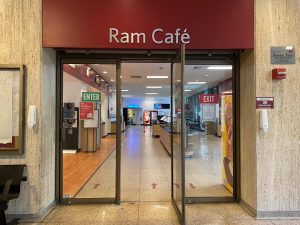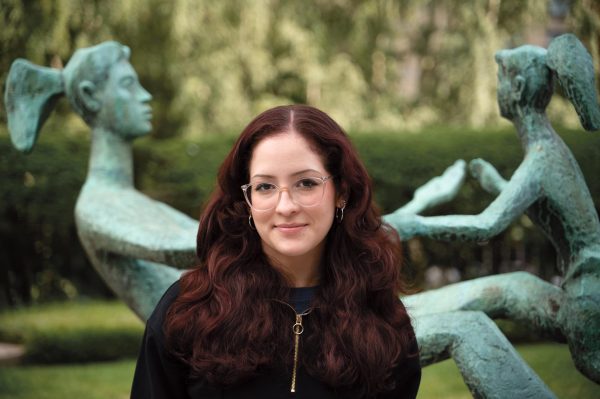Aramark Makes Dining Changes at Lincoln Center
Despite the expansion of food options, students remain wary of the food quality and meal offerings
Schmeltzer Dining Room has two new cuisine options: sushi and Mexican stations.
September 29, 2022
Fordham’s dining provider Aramark introduced new changes at the Lincoln Center campus for the fall 2022 semester, including the expansion of dining options and sustainability-oriented initiatives.
The adaptations include two new food service stations at Schmeltzer Dining Room, located on the second floor of Fordham’s Law School, which now caters sushi and Mexican cuisine. The Cronin Café, found in the library on the sixth floor of the Law School building, has switched to a new coffee supplier called La Colombe, a well-known chain with several locations throughout the city.
In the Community Dining Hall, Aramark has introduced Babylon micro-farms, which grow fresh produce to be used by the service provider’s culinary team. The Ram Café has replaced Grille Works with a new station, “Burger & Fries,” which serves burgers as well as classic signature menu items such as chicken tenders.
“We take in feedback every semester in a variety of different ways to learn about the evolving needs and wants of our students” Rachel Diaz, marketing manager for Aramark
The university has also continued the “Our Greens To-Go” take-out program, where students at both Lincoln Center and Rose Hill dining halls have access to reusable containers.
Rachel Diaz, marketing manager for Aramark, added that they will also launch a program later in the semester called “Cool Foods” which aims to create a “low-carbon footprint dining experience.” The program includes labeling qualifying meals as low-carbon footprint dishes and educating students on how to find these offerings.
“The changes that we make are prompted with our students and mission in mind,” Diaz said. “We take in feedback every semester in a variety of different ways to learn about the evolving needs and wants of our students.”
Lauren Owen, Fordham College at Lincoln Center (FCLC) ’25, shared that when she had a meal plan as a first-year, she preferred alternative on-campus dining establishments over the Community Dining Hall.
Owen said she believes that Aramark’s increase of diversity among dining options is a positive change.
“It was very much a hit or miss,” she said. “But I frequented Schmeltzer’s a lot. I just got the same thing every time.”
While Owen chose not to purchase a meal plan this semester, hearing about the new sushi station at Schmeltzer made her excited about potentially reenrolling in a plan for the next semester.
In regard to incorporating different cuisines into dining options, Diaz said that Aramark “takes into account the different food and cultural trends when conceptualizing our offerings.”
Owen said she believes that Aramark’s increase of diversity among dining options is a positive change.
“I’m glad they instituted it because they don’t have much ethnic food,” she said.
Nicholas Wesley, FCLC ’24 and a resident assistant in McMahon Hall, had a meal plan during his first two years at Fordham. He echoed Owen’s thoughts on Schmeltzer, saying he went there often because it was “the most consistent place.”
He added that he is glad to see the expanded dining options available at Schmeltzer.
“I saw some email about how they are having some Mexican restaurant caterer there,” Wesley said about the new station named “Zoca Fresh Mexican Flavors.” “I feel like it’s a good attempt at a little bit more inclusivity with the food options and catering to different cultural needs.”
Wesley chose not to purchase a meal plan this semester, due to his previous experience.
Someya also believes that among current menu options at the Ram Café and Community Dining Hall, there can be some more diversity in offerings and improvement in quality.
“It’s very lackluster; it’s not anything really exciting, restaurant quality of course,” Wesley said, describing the dining options at Lincoln Center. “It’s just something you eat to survive, if you don’t want to go out and spend at least twenty dollars on DoorDash, that’s just what you eat to make it by.”
Miu Someya, FCLC ’24 and a student with a meal plan this semester, agreed with Wesley’s feedback on the dining services.
“The quality of the dining options at Lincoln Center aren’t the best in my opinion,” Someya said. “I think the meal plans are too pricey.”
Someya also believes that among current menu options at the Ram Café and Community Dining Hall, there can be some more diversity in offerings and improvement in quality. She noted that for commuters like herself, the Ram Café is one of the most accessible and convenient options.
“The food quality is not that good,” Someya said. “I feel like they can improve the vegetable and meat products they use.”
In addition to Ram Café, Someya goes to Argo Tea and said that because they aren’t part of Aramark, she feels that the quality is better.
On any upcoming and continuing changes, Diaz noted that Aramark is “looking forward to building these efforts even further and (is) excited to introduce new concepts, offerings, and innovations in the near future.”
















